Ford Kuga ST-Line PHEV long-term test
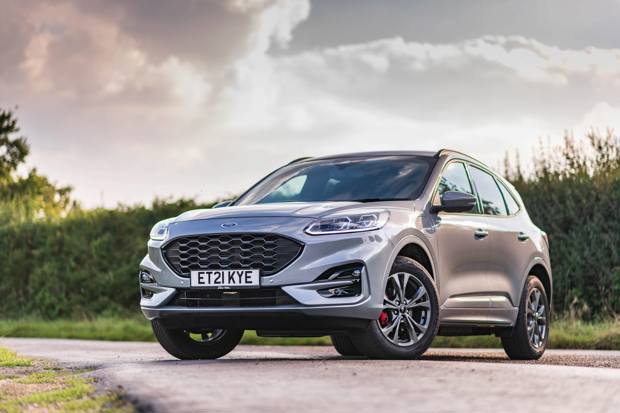
Specifications: Ford Kuga ST-line 2.5 Duratec PHEV
- Run by: Phil Hall since September 2021
- Price when new: £36,555 (£37,555 including options)
- Engine: 2.5-litre plug-in hybrid
- Power: 225PS
- Torque: 200Nm
- Claimed economy: 201.8mpg
- CO2 emissions: 32g/km
- Insurance group: 21
- Report 1: We welcome a Ford Kuga ST-Line PHEV to the fleet
- Report 2: Living with a plug-in Kuga
- Report 3: How practical is the boot?
- Report 4: Finding the Kuga PHEV's controls refreshingly easy to use
- Report 5: The Kuga PHEV's drive modes explained
- Report 6: Is the FordPass app worth downloading?
- Report 7: Our Ford Kuga and the rigours of family life
- Report 8: Freezing temps reduces our Kuga's hybrid range
- Report 9: Ford Kuga vs Volkswagen Tiguan
- Report 10: A fond farewell to our Ford Kuga
Report 1: We welcome a Ford Kuga ST-Line PHEV to the fleet
New boy Phil get his hands on Ford's new(ish) hybrid SUV, the Kuga PHEV. What do we think of it so far?
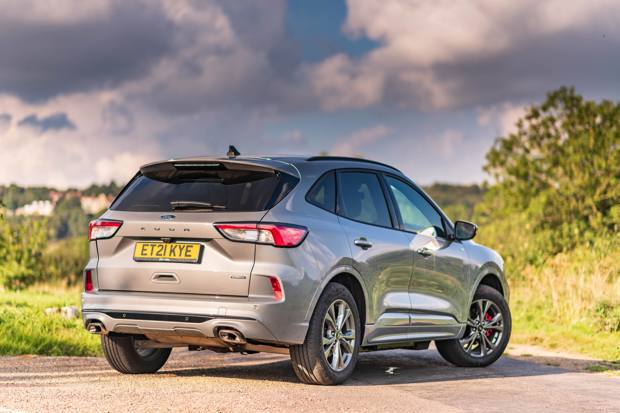
Date: 17 September 2021 | Current mileage: 2006 | Claimed economy: 201.8mpg | Actual economy: 55.4mpg
With the growing interest in hybrid powertrains and with the Kuga regularly cropping up as one of the most searched for cars, we were keen to see what the Kuga PHEV was like to live with over a longer period of time.
First though, a quick recap of the main features of our Ford Kuga. Though prices start at just under £27,000 for a Kuga in Zetec trim with a 1.5-litre 150PS petrol unit and 6 speed manual 'box, ours sits further up the range, coming in a more appealing ST-Line. To our eyes at least, the ST-Line's body styling kit sharpens up the look of the Kuga nicely over the Zetec and Titanium trims. There's a more aggressive frontend and large rear spoiler.
ST-Line trim cars also come with 18-inch 'Rock Metallic' alloy wheels, and while they probably don't quite fill the wheel arches as imposingly as the 19-inch alloys that are standard with ST-Line X cars (or the optional 20-inch alloys that Georgia's Kuga had), the trade-off should be a slightly comfier ride, especially with the ST-Line's sports suspension. Our Kuga PHEV is also finished in what Ford calls Solar Silver. This £600 option does look really nice in the flesh, with a number of people commenting how smart it looked in that colour. And it's certainly a handsome looking car, but possibly just a little too forgetful?
Pick the Kuga in ST-Line spec and it comes with an impressive list of standard features that includes full LED headlamps, front and rear parking sensors, rear view camera, full digital 12.3-inch instrument cluster, 8-inch touchscreen, Apple CarPlay and Android Auto connectivity, keyless entry, wireless phone charging, cruise control, lane-keeping aid and a B&O premium sound system.
Some buyers might be tempted to splash the cash and get the Driver's Assistance Pack for £1,100. This includes a front-facing camera, adaptive cruise control, blind spot information system and Ford's Active Park Assist. While our long term Kuga PHEV doesn't come for this, it does come with a £400 Winter Pack, with heated front seats and steering wheel that should help keep us nice and toasty over the winter months.
What about the engine then? Our Kuga features a 2.5-litre petrol engine that's married to an electric motor and delivers a combined 225PS. There's a moderately brisk 0-62MPH time of 9.2 seconds, and as a plug-in hybrid, the Kuga PHEV has a battery-only range of 35 miles. There's a choice of four EV modes so you can tailor the combination of petrol and electric power to suit your journey, but we'll cover that in more detail next time.
That all brings the on the road price of the Kuga to £37,555. That's a lot for a Ford, but we're really interested to see how the Kuga PHEV fits into family life over the next few months with our long term test. Is it going to deliver the best of both worlds or a compromise to far? And just how close can we get to that promised 200+ mpg? From the school run to longer trips with a fully loaded car, we'll hopefully get under the skin of the Kuga PHEV and find out how it stacks up as a verstatile family wagon.
Report 2: Living with a plug-in Kuga
When I promised I was going to go into more detail about the Kuga's EV modes next time, I didn't think I'd have such a timely reason to do so. With the fuel shortage in full swing the Ford Kuga PHEV has really come into its own and made a really good case for running a hybrid car.
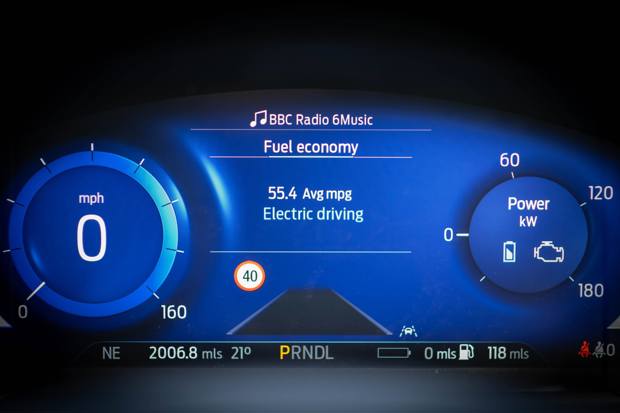
Date: 5 October 2021 | Current mileage: 2214 | Claimed economy: 201.8mpg | Actual economy: 60.9mpg
I'm ashamed to say that I'd let the tank in the Kuga run pretty low before the fuel crisis hit, with just over 60 miles estimated before I'd be running on fumes. In the middle of work and when the first signs that petrol station forecourts were running dry, I didn't get a chance to fill up before things got even worse.
The next week saw us needing the car for not only the school run, but a few trips further afield that would mean covering a few junctions on the M25 and back. A 60-mile range wasn't going to cut it.
Normally this would mean having to pay attention to the neighbourhood WhatsApp group and the reports of local fuel deliveries before rushing out to queue for an hour or so to get petrol. With the Kuga PHEV though I could simply hook it up at night to a three-pin plug socket in the garage and in the morning I'd have a range of 36 miles of electric power at my disposal.
Up until now I had been relying on using the Kuga PHEV's EV Auto setting that lets the car's computer work out what's the most efficient combination of petrol and electric power. Because I wanted to conserve as much fuel as possible though for longer runs later in the week, I opted to swap to the Kuga's EV Now mode initially for the shorter runs that I was doing. This prioritises using the Kuga's battery and will only swap to the petrol engine once power has been depleted or your tell it to do so. There are another couple of modes as well, with EV Charge topping up the battery using the engine, and EV Later that holds the state of charge for, well, later.
We were then wafting around under all electric power, and while a dedicated electric car is certainly more efficient as it's not having to lug a ICE around as well, the Kuga PHEV did a remarkable job. We could happily do the school drop off and pick up with it, as well as run other errands throughout the day before topping up the battery at the end of the day.
For two days in the week we needed to make some longer journeys, with two round trips of just over 40 miles. Obviously if I was just running a petrol car the 60 mile fuel range wasn't going to cut it, but life was stress free with the Kuga PHEV. Simply making sure it was fully charged, both trips were easily completed with only a small amount of petrol used on each journey.
Over one week when the fuel crisis was at its worst we ran the Kuga PHEV for over 120 miles on electric power alone, and only burnt through a few miles of petrol at the same time. The Ford Kuga PHEV is already proving its worth.
Report 3: How practical is the boot?
Until recently, our family car for the last few years has been a Skoda Octavia estate. While it might not be the most striking car on the road, it's been perfect for family life, especially with two small girls and a dog to cart around.
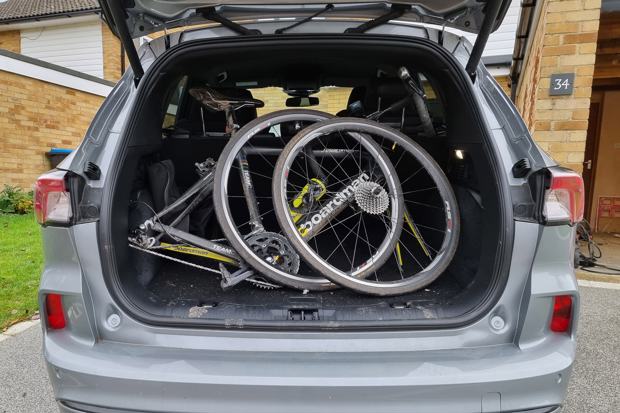
Date: 19 October 2021 | Current mileage: 3029 | Claimed economy: 201.8mpg | Actual economy: 63.8mpg
When I started running the Ford Kuga PHEV I was a little nervous about how it was going cope with the various load demands we'd be throwing at it. We'd been spoilt with the Octavia's large 610-litre boot capacity in recent years and the Kuga PHEV's 411 litres seemed quite a downgrade.
I've been pleasantly surprised, though. Thanks to the ability to bring the rear bench seats forward, you can increase boot capacity in the Kuga PHEV to 526 litres if you need a bit more space, while there's some decent storage under the boot floor. It's designed to stowaway the charging cables (and it does mean you sacrifice a space-saving tyre), but it's a handy space for smaller items if you leave the charging cables at home.
I haven't had to do a tip run or trip to IKEA thankfully since I got the Kuga PHEV, but I can always drop the rear seats down as well if I need to. They don't fold that flat annoyingly, but with them down it does provide a load space 1481 litres. It's not going to rival an estate like the Octavia, but useful enough for most situations.
We've managed to put the boot to the test with a couple of trips away recently, and it's been more than up to the job and I haven't needed to pull the rear bench seats forward, giving the girls more room in the back. The boot's easily swallowed up what we've packed with space for more.
This might sound a little odd, but I can squeeze my bike in the boot of the Kuga PHEV a little easier than I could with the Octavia. It's probably down to the extra height of the Kuga PHEV, which also means there's more useful space around it for other luggage.
She hasn't said anything, but we think our dog Mary misses the Octavia though. Whether that's down to the easier access of the boot on the Skoda or the slightly bigger footprint if offers, she hasn't quite gelled as well with the Kuga PHEV as we have.
What about that MPG? It's been going really well on short trips on electric power alone, but on longer trips when the petrol engine needs to kick in, you can see the average MPG drop down significantly. Will be interested to see how it fairs once the cold weather hits.
Report 4: Finding the Kuga PHEV's controls refreshingly easy to use
The explosion of touchscreens in cars over the last few years has brought a significant change in interior car design, allowing engineers to deliver a much more streamlined look with fewer buttons littering the cabin.
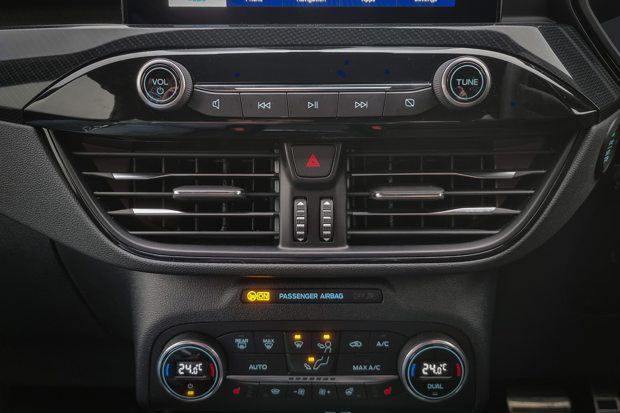
Date: 3 November 2021 | Current mileage: 3106 | Claimed economy: 201.8mpg | Actual economy: 65.6mpg
The responsiveness of the latest capacitive touchscreens is so much better than the resistive touchscreens of old, with this older tech requiring a serious prod to provoke any response on the display. This advance in tech has allowed the likes of Volvo and Audi to rely heavily on a car’s touchscreen to access huge swathes of the car’s controls, leaving only a few buttons on the central console.
Alongside these sleek and clutter-free interiors, the Ford Kuga PHEV’s central console does look a bit dated, with buttons and knobs dominating the dashboard. However, while it looks like a 90s Aiwa mini hi-fi, it’s refreshingly intuitive to use.
For instance, while there’s a growing trend for car manufacturers to force you to go through the faff or setting the climate control from the touchscreen, the Kuga PHEV has two large dials that are easy to control.
There’s also dedicated buttons for the heated seats and steering wheel (which are really starting to come into their own now it’s started to get colder), while there are dedicated buttons for both the EV modes and drive modes (more on those in another update).
Another thing that’s often buried in the touchscreen menu is the option to turn the Lane Keeping System off, but the Kuga PHEV keeps things nice and simple with a single press of a button that’s positioned on the left-hand turn signal stalk.
The cruise control is also really easy to set and adjust thanks to the logically laid out controls on the steering wheel. It might not look like a sophisticated Scandinavian lounge, but it’s so easy to live with and use on a daily basis.
Elsewhere and the Kuga PHEV’s proving to be a dependable family wagon. Whether it’s short journeys to school (when it’s too wet to walk or ride bikes) or longer family trips, it soaks it up.
Report 5: The Kuga PHEV's drive modes explained
For people looking at buying a Ford Kuga, one of the most asked questions is whether it has four-wheel drive or not. The short answer is that if you're buying new, there's no longer the option to spec a AWD Kuga.
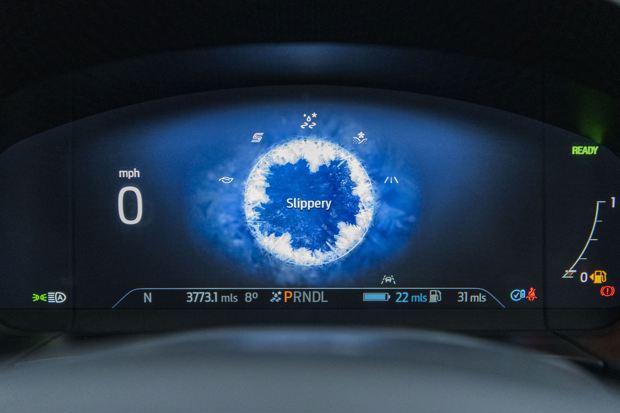
Date: 17 November 2021 | Current mileage: 3234 | Claimed economy: 201.8mpg | Actual economy: 66.1mpg
You see, Ford recently stopped offering the Kuga with a 2.0-litre diesel, which was the only model that could be specified with a four-wheel drive system. That means that our Kuga PHEV is front-wheel drive, with the motors powering the front wheels as well as the petrol engine. Some other systems from other manufacturers tend to divide power, with electric power driving the rear wheels.
It's not going to be troubling more focused 4x4s when conditions and terrain get really sketchy, but it does offer five driving modes to tackle an array for different conditions.
These can be easily accessed from a botton on the central console, with Normal, Sport, Slippery, Snow/Sand assist and Eco modes to choose from. Swapping between the modes alters acceleration, steering and suspension, while also adjusting the traction and stability controls.
Reality is you'll probably have it in Normal mode for most of your driving and that's true with the miles that we've covered in the last couple of months. However, now it's getting colder, a couple of other driving modes are making a case for themselves.
It's not quite off-roading, but parking the car at the edge of a wood to walk the dog has got increasingly slippery in recent weeks. A mix of leaves and deep mud covering the ground mean it's been a bit of a no-go area in our Skoda Octavia in recent years when winter arrives. But the extra traction the Kuga provides when set to 'Slippery' makes it doable.
With no sign of any snow just yet there's been no chance to try it in 'Snow/Sand', but switching to 'Sport' does liven up the whole car. The throttle response is that bit sharper, giving it noticeably more punch, while the steering gets heavier as well. You wouldn't want to bomb around in this mode all the time, especially if you've got one eye on your MPG, but it's certainly welcome when the road opens up a bit.
While the lack of an AWD Kuga might be disappointing for some, reality is that it's more than up to the job of typical UK driving conditions throughout the year, especially if you fit some good winter tyres.
Report 6: Is the FordPass app worth downloading?
Like a lot of car manufacturers, Ford has created its own app, titled FordPass. But is it actually any good and worthwhile downloading? To see what, if any, benefits the FordPass app brings to Kuga PHEV ownership, I thought I'd give it a whirl.
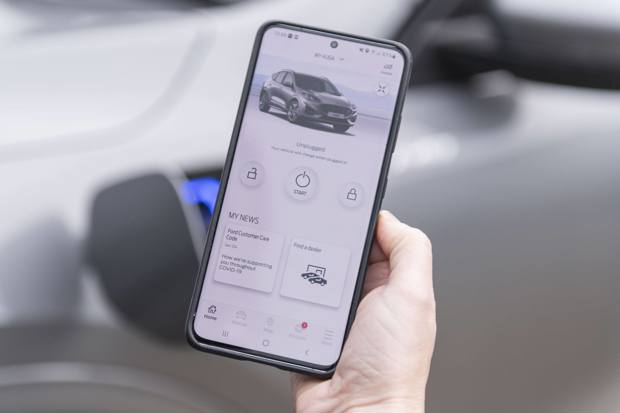
Date: 1 December 2021 | Current mileage: 3465 | Claimed economy: 201.8mpg | Actual economy: 67.3mpg
Once you've registered and tapped in your VIN (the app helpfully shows you where to find it on the car), you're off. Literally. The homescreen gives up the option to both remotely unlock your car as well as starting it (and locking it as well). Handy if it's cold outside and you want to warm it up first. However, there's a much better way to get this warmed up inside on a cold day before setting off.
With the Kuga PHEV plugged in to charge, you can schedule estimated departure times each day and tell the car what temperature you want the cabin temperature to be. While it doesn't allow you to be that precise (the golden 22 degrees isn't possible), it does give you the option to set it at Cool, Medium or Warm. With the first few really cold days starting kicking in, it's been great to have the car pre-warmed ready for the school run and avoid the cries of 'it's cold in the car'.
You can also schedule the hours when it charges. So rather than coming home at the end of the day and plugging it in when you get out of the car and still potentially paying the higher tariff on your electricity bill, you can tell the Kuga PHEV to only charge later on in the evening once energy prices come down.
It's not just about finessing the charging with the FordPass app, as there are a number of other features as well. You can quickly check the status of the car, while it's also your window to the car's servicing intervals (we've got another 14,000 miles or so before it's scheduled for its first service).
It also has a number of location services as well, with details of the nearest fuel and electric stations, as well a nearby parking. You can also plot your route from the comfort of your home before sharing the route with your Kuga PHEV so you'll have your route already mapped out in the car's navigation system before setting off. Alternatively you can also send the route to other apps, including Google Maps and Waze.
That all sounds great and in principal it is, but at least on the Android smartphone I paired it with, it was just a bit too slow and on at least 50% of the time, wouldn't sync my desired settings. I'm not the only one. A glance at a raft of user reviews shows a lot of disgruntled users who've got fed up with the clunkiness of the app and it's inability to perform simple commands.
I've had a more positive experience than most from the looks of things, but it's hard to recommend when it's not as reliable as it should be. If they can get the bugs fixed then the FordPass app is a geniunely useful app for any Ford PHEV or electric car owner.
Report 7: Our Ford Kuga and the rigours of family life
You'd have to be living under a rock the last five or so years to not notice that and SUV has become the family car of choice. Hatchbacks and estates now seem almost a leftfield choice now that most manufacturers have jumped on the SUV bandwagon.
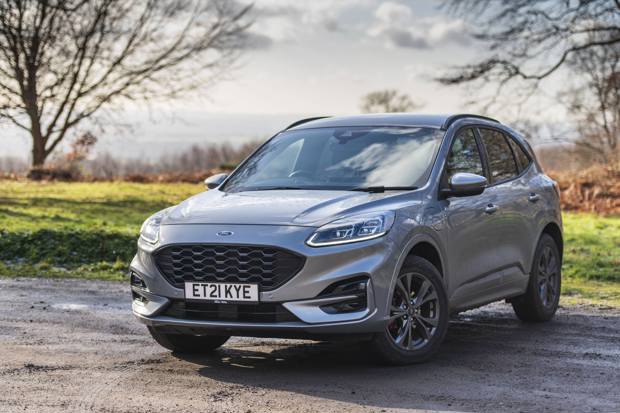
Date: 29 December 2021 | Current mileage: 3798 | Claimed economy: 201.8mpg | Actual economy: 68.5mpg
Despite such a fierce market, the Ford Kuga is one of the best-selling family SUVs you can buy. But does it deserve its illustrious place in these car sales charts? Having run the Ford Kuga PHEV for a good four months now, I thought it would be a good point to take stock and look it how it's coped with what we've thrown at it as a family.
With two girls under five, the back seats have been filled with two car seats that have easily hooked up to the ISOFIX mounting points, while the sliding rear bench seat means we can tailor the space in the back depending if we need more room in the boot or not. One niggle that has been a constant frustration has been the pretty rigid mounting of the seat belt buckle. That means it can be really fiddly putting the seat belt on when our eldest daughter is in her car seat.
Once belted up, the Kuga PHEV has been fantastic on the short school run when we do it. With the Kuga plugged in overnight, we can whisk the girls to school and preschool in near silence without the need for the petrol engine to kick in at all. It's also nice to know that thanks to the five-star Euro NCAP rating of the Ford Kuga, they'll be protected should the worst happen.
The standard kit of front and rear parking sensors and rear camera on our Ford Kuga ST-line has taken a lot of the stress out of navigating the often tight parking spaces in our local town. The optional Driver's Assistance Pack includes a front-facing camera and Ford's Active Park Assist at an extra £1100, and while these are nice things to have, we haven't missed not having them on ours.
Out of town and on longer trips with the car fully loaded, the Kuga's been a dream. Sure, there's certainly more exciting cars to be behind the wheel of if you need to eat up loads of motorway miles, but if you want to get to your destination in comfort and not have to listen to cries of 'I feel travel sick' coming from the back, then the Kuga has a big tick against its name.
The only real complaint is the fuel economy on longer trips - and that's not an issue unique to our Kuga PHEV, but something all PHEV hybrids suffer from. Once the battery power has depleted, the batteries are a lot of extra weight to lug around and you'll see the average MPG take a nosedive.
The Kuga is also one of the better handling SUVs in its class as well. It's certainly not going to trouble a hot hatch (or even a warm hatch for that matter), but flick the Kuga PHEV into its Sport mode sharpens up the throttle response and steering for a more engaging drive on the right road. All this makes the Ford Kuga PHEV and incredibly versatile car.
Report 8: Freezing temps reduces our Kuga's hybrid range
With the arrival of colder weather we see the electric-only range of our Kuga take a bit of a hit.
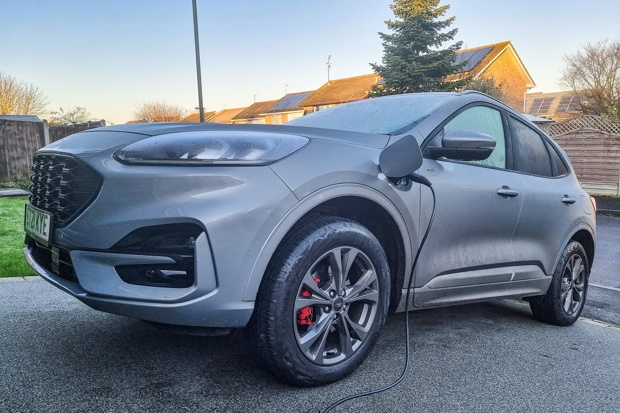
Date: 12 January 2022 | Current mileage: 3901 | Claimed economy: 201.8mpg | Actual economy: 68.1mpg
However, the arrival of freezing temperatures in recent weeks has seen the electric-only range take a bit of a nosedive. That 36-mile electric-only range of the Kuga PHEV that we have been enjoying has dropped on average to around 24 miles when there's frost overnight, and in some instances it's only been hovering at around 18 miles when it's unplugged in the morning.
I've tried to reduce this by starting the car remotely before leaving in the morning (with the car still plugged in). I've tended to do this via the Ford Pass app, though I've taken the simpler route of hitting the start button on the app rather than pre-programing it to be up to temperature by a specific time as I found the app to just be too buggy.
But reduced battery charge isn't unique to the Kuga PHEV. The simple fact is that when temperatures drop below the optimum operating range of a battery, performance is going to be compromised and it's an issue that will affect all hybrid (and electric) cars to a certain degree.
Probably not helping matters is the heated seats and steering wheel. These have been an instant hit and make those early winter mornings that bit more bearable.
It's also worthing highlighting that both the seats and steering wheel on the Kuga PHEV get nice and hot very quickly - a trait that not all cars with these features can boast. The Toyota RAV4 for instance took noticeably longer to heat both the seats and steering wheel when on test.
And we couldn't mention frosty mornings without a nod to Ford's Quickclear Heated Windscreen tech that the Kuga PHEV benefits from. I haven't had to head outside and get the scraper out once this winter, letting the super-thin filaments do their thing.
Granted, doing it the correct way and letting the car come up to temperature gradually would see the range improve, but life isn't always as pre-planned as that.
Report 9: Ford Kuga vs Volkswagen Tiguan
We get behind the wheel of one of the Kuga's closest rivals to see how it compares.
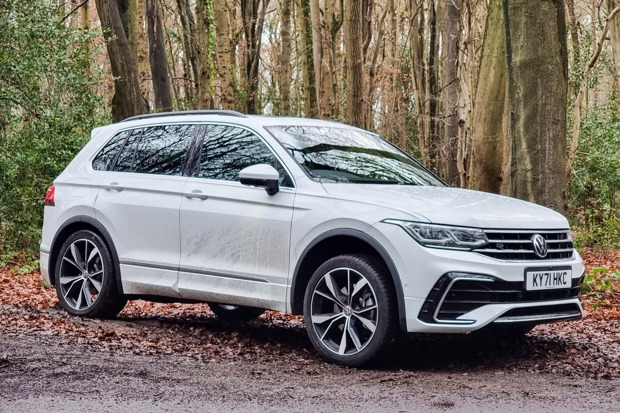
Date: 26 January 2022 | Current mileage: 4012 | Claimed economy: 201.8mpg | Actual economy: 69.5mpg
Let's take a look at the stats first. While our Kuga PHEV sports a 2.5-litre petrol engine that delivers a combined 225PS with the aid of the electric motor, the Tigan PHEV does things a little differently. Powering the VW family SUV is a 1.4-litre petrol engine that when combined with the electric motor, delivers 245PS. The Tiguan will hit 62MPH in 7.5 seconds - some 1.7 seconds faster than the Kuga.
Behind the wheel, and it's the Tiguan that weirdly feels more laboured getting to 62MPH - the Kuga seems to make much less fuss about it. The electric range of the Kuga PHEV edges the Tiguan PHEV however, officially delivering up to 39 miles of electric-only range compared to 30 from the Tiguan.
Our Tiguan PHEV came in VW's sport R-Line spec, rivalling the Kuga PHEV's ST-Line trim, but the Tiguan will set you back some £2000 more at £38,935, compared to £36,905 for the Kuga. Want a Tiguan plug-in hybrid without the sporty trim of the R-Line, then you can have one in entry-level Life trim from just over £36,000.
Where does that extra money go? For starters it has the beefier 20-inch alloys (though the ride is noticeably firmer than the Kuga), while our test car had the large 10.3-inch digital instrument cluster that's certainly a step above the one in the Kuga. There's also plenty of driver aids as standard in the Tiguan, but some we could do without.
The Travel Assist is designed to make motorway driving less tiring, but I lost track of the times going round the M25 and M1 that it thought the speed limit had changed from 70 to 50 and jammed on the brakes. Our Kuga doesn't have adaptive cruise control, so we can't say how this performs, but the bog standard cruise control in our car has worked a treat.
Inside and the Tiguan has the edge here, but it's not as clear-cut as you'd think. It's certainly a bit more premium, but the Kuga's interior gives it a good run for its money. The Kuga's controls are more intuitive as well - the clear temps dials of the Kuga were much better than the overly clever temp controls on the Tiguan that require to to swipe your finger to change the temperature. Talk about a faff.
In terms of boot space though and the Tiguan has the noticeable edge here at 615 litres compared to 526 litres in the Kuga. So, which would we have given the choice? Well, before living with the Kuga I'd have said the Tiguan, but I'd probably be tempted by the Kuga. It might not have quite the same presence, but it does an awful lot of things very well and I'd save myself a couple of grand at the same time.
Report 10: A fond farewell to our Ford Kuga
After six months and more than 3000 miles, it’s time to say goodbye to our Ford Kuga PHEV. It's become a firm favourite in the Hall household and we’re sorry to say goodbye.
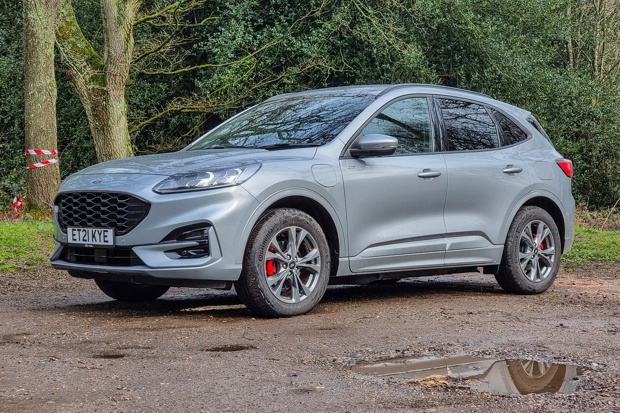
Date: 9 February 2022 | Current mileage: 4377 | Claimed economy: 201.8mpg | Actual economy: 69.5mpg
The Kuga has done everything we've asked of it as a family car and more. The plug-in hybrid tech has made it a brilliant car for the school run, zipping around on electric power alone, while it'll happily get through plenty of motorway miles with effortless ease.
While it's probably not going to trouble an estate for ultimate boot space, the Kuga plug-in hybrid has still proved to be incredibly versatile. In the past six months we've taken it on holiday to the coast, weekends away with the bike and more and we've never been short on space.
During our time running it, we've clocked up almost 3000 miles and it's hard to find fault with it. The cabin is nice and comfy, while the dashboard controls are logically laid out and intuitive to use. Both the front and rear passengers get acres of space, with the sliding rear bench seat offering even more flexibility when needed.
On each time of asking, the Ford Kuga hasn't faltered and been incredibly dependable. In the six months of running it, we're pleased to report that we haven't had cause to run it back to the nearest Ford dealer. It's certainly worked it's way into my affectections and would be a car that i could quite happily live with for a couple of years.
Our ST-Line Kuga hits the sweet spot when it comes to kit as well. This includes the snazzy bodykit, leather sports seats, Apple CarPlay and Android Auto as standard (though not with wireless connectivity a little annoyingly), 12-3-inch digital instrument display, keyless entry and a rear camera.
For an large family SUV the Kuga was also pretty impressive on the road. The responsive steering delivers as rewarding and enjoyable driving experience, while still feeling refined on Surrey's Third World road surfaces. It might not be the quickest plug-in SUV, but the hybrid power in Sport mode should be enough for most people's SUV needs and there's plenty of grunt when needed.
Okay, I didn't quite hit the magical 201.8mpg that Ford claims, with just over 70mpg being the best. That said, that's still very good for a large SUV. A lot of that is thanks to undertaking short trips - be prepared to see that dip quite a bit on those longer journeys however.
It's easy to see why the Ford Kuga is one of the best-selling cars at the moment. It does an awful lot of things very well and it would certainly be at the top of my list if I was in the market for a large and comfy family-sized SUV.
